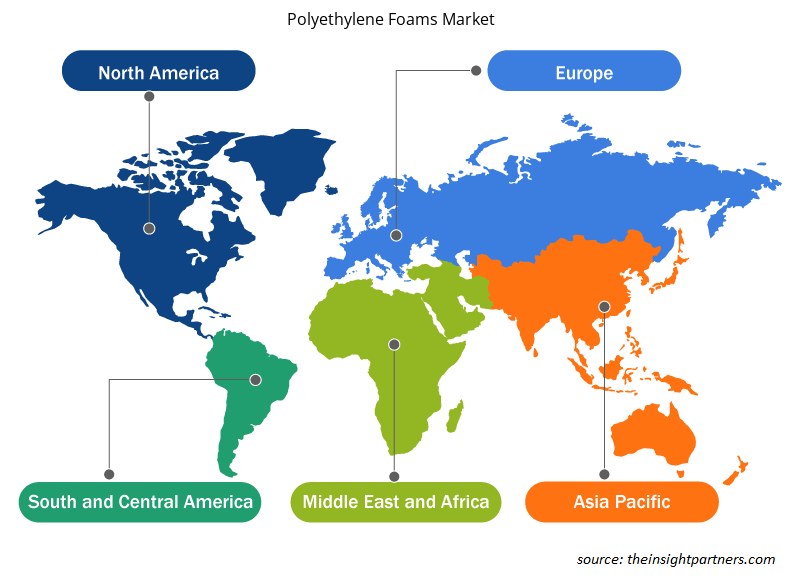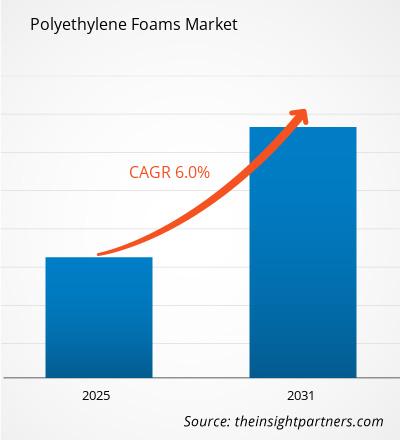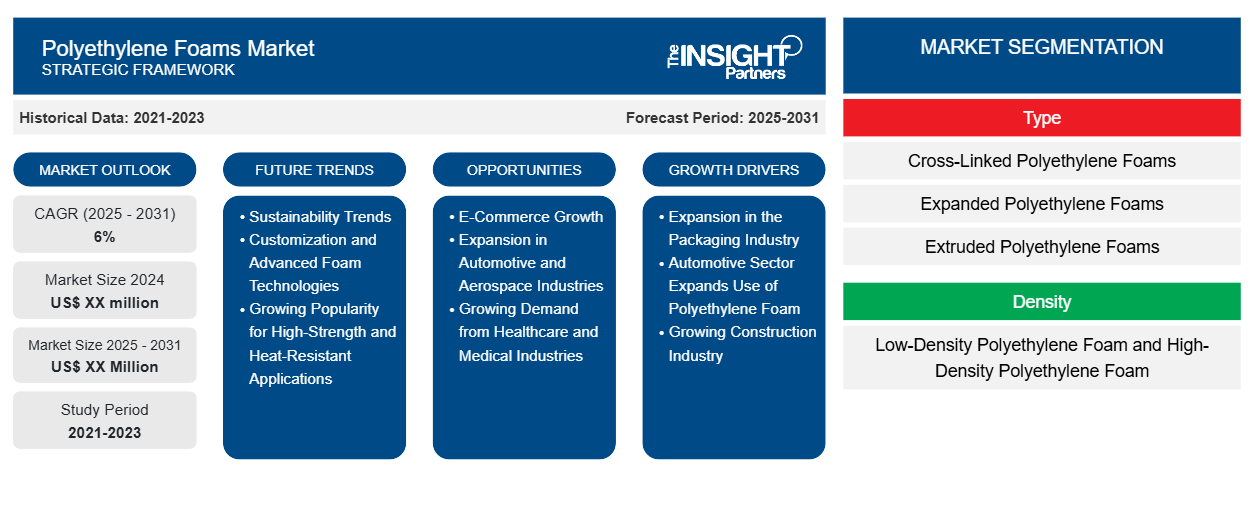聚乙烯泡沫市场预计在 2023 年至 2031 年期间的复合年增长率为 6%,市场规模将从 2023 年的 XX 百万美元扩大到 2031 年的 XX 百万美元。
聚乙烯泡沫市场报告按类型细分(交联聚乙烯泡沫、发泡聚乙烯泡沫和挤压聚乙烯泡沫)。市场根据密度细分(低密度聚乙烯泡沫和高密度聚乙烯泡沫)。市场根据应用细分(包装、汽车、建筑和施工、医疗、体育和休闲等)。全球分析进一步细分为区域和主要国家。范围涵盖所有关键细分市场的全球、区域和国家层面的市场规模和预测。该报告以美元为单位提供了上述分析、细分市场、地区和国家的价值。报告涵盖市场趋势以及市场动态,如驱动因素、限制因素和关键机会。报告还涵盖行业格局和竞争分析,包括市场集中度、热图分析、知名参与者和市场最新发展。
报告目的
The Insight Partners 的《聚乙烯泡沫市场》报告旨在描述当前形势和未来增长、主要驱动因素、挑战和机遇。这将为各种业务利益相关者提供见解,例如:
- 技术提供商/制造商:了解不断变化的市场动态并了解潜在的增长机会,从而能够做出明智的战略决策。
- 投资者:对市场增长率、市场财务预测以及整个价值链中存在的机会进行全面的趋势分析。
- 监管机构:监管市场政策和警察活动,旨在最大限度地减少滥用行为,维护投资者的信任和信心,维护市场的完整性和稳定性。
聚乙烯泡沫市场细分
类型
- 交联聚乙烯泡沫
- 发泡聚乙烯
- 挤塑聚乙烯泡沫
密度
- 低密度聚乙烯泡沫和高密度聚乙烯泡沫
应用
- 包装
- 汽车
- 建筑和施工
- 医疗的
- 运动休闲
地理
- 北美
- 欧洲
- 亚太
- 南美洲和中美洲
- 中东和非洲
地理
- 北美
- 欧洲
- 亚太
- 南美洲和中美洲
- 中东和非洲
定制此报告以满足您的需求
您可以免费定制任何报告,包括本报告的部分内容、国家级分析、Excel 数据包,以及为初创企业和大学提供优惠和折扣
- 获取此报告的关键市场趋势。这个免费样品将包括数据分析,从市场趋势到估计和预测。
聚乙烯泡沫市场增长动力
- 包装行业的扩张:聚乙烯泡沫市场增长的因素之一是包装行业对这种泡沫的高消费量。聚乙烯泡沫被视为制造包装材料的理想聚合物,因为它具有良好的减震、缓冲和保护能力,特别是对于电子设备、玻璃、家具等精致或易碎的商品。随着电子商务的扩张和全球贸易的扩张,对合适且价格合理的包装的需求不断增加。包装的保护性、可重复使用性和环保性越高,对聚乙烯泡沫的需求就越大,特别是在包装完整性是关键问题的行业中。
- 汽车行业扩大聚乙烯泡沫的使用:汽车行业也是支持聚乙烯泡沫市场的另一个重要因素,因为 PE 泡沫用于许多汽车零部件,用于吸音、减震和软装饰等应用,因此它在许多汽车中都有应用。由于其重量轻、隔音和减震性能好,它还越来越多地用于汽车座椅和车顶内衬。此外,全球汽车工业的扩张,特别是在发展中地区,将增加对 PE 泡沫的需求,因为需要轻质和坚固的材料来增强车辆的性能、安全性和舒适性。
- 建筑业发展:聚乙烯泡沫的另一个重要建筑市场应用是其非常有效的防潮层,可在结构内形成隔热层。它由 PE 泡沫制成的隔热层组成,放置在墙壁、天花板、地板和屋顶上,以增强隔热、节能和隔音效果。人们对能源效率的关注度不断提高,对绿色建筑的偏好也不断增加,这使得 PE 泡沫在建筑行业得到广泛应用。
聚乙烯泡沫市场未来趋势
- 可持续发展趋势:可持续发展是消费者和生产商共同关注的关键,此外,聚乙烯泡沫市场正在向绿色解决方案转变。由于监管压力和消费者对绿色产品的偏好越来越高,制造商正在研究生物基和再生 PE 泡沫。对生物基聚乙烯泡沫等解决方案的研究被认为是近期市场增长的创新。随着环保生产方法的出现,该领域有望实现一定增长,因为大多数制造商都面临着减少运营碳排放的压力。
- 定制和先进泡沫技术:定制和高性能聚乙烯泡沫产品的生产正在增加。先进的泡沫技术可以精确调整泡沫密度、质地和厚度,这是泡沫制造商的首要任务。这些创新使聚乙烯泡沫能够满足汽车、航空航天、医疗和电子等行业的需求。最近,医疗行业的 PE 泡沫已被设计用于生产防护垫、矫形支架和缓冲材料。然而,由于行业需求,定制聚乙烯泡沫解决方案将开始转向更先进、更耐用的材料。
- 高强度和耐热应用领域日益流行:交联聚乙烯 (PEX) 泡沫比普通 PE 泡沫更坚固,且具有更好的抗机械降解性,因此在许多领域越来越受欢迎。PEX 泡沫的应用领域也正在扩大,包括高强度、腐蚀性介质和隔热应用,例如汽车、航空和航海工业。
聚乙烯泡沫市场机遇
- 电子商务增长:聚乙烯泡沫制造商的机会之一是抓住电子商务和在线零售的增长机遇。由于在线销售的产品份额将继续增加,对安全、保护性包装解决方案的需求也在增长。聚乙烯泡沫成为最受欢迎的包装材料之一的原因之一是其缓冲能力,可以在运输过程中保护易碎物品。在这个快速发展的市场中,包装环境的可持续性将使公司能够开发可回收或可生物降解的 PE 泡沫,以满足消费者和监管机构对更环保产品日益增长的需求。
- 汽车和航空航天业的扩张:汽车和航空航天市场存在巨大的增长机会,这两个市场都越来越依赖轻量化来实现燃油效率。大多数汽车制造商都使用 PE 泡沫作为轻量化材料,它用于许多应用类型,包括座椅垫、内饰板和车顶内衬。在飞机中,航空航天业使用 PE 泡沫作为绝缘和减震材料。由于轻量化和节能材料对这两个行业都越来越重要,这些不断发展的行业对聚乙烯泡沫的需求将会增长,从而为这些行业的聚乙烯泡沫供应商带来新的未开发市场机会。
- 医疗保健和医疗行业的需求不断增长:医疗保健和医学领域出现了 PE 泡沫市场的新前景。从骨科保护垫到医院病床上的床垫,甚至医疗包装,PE 都用于众多医疗应用中。随着对医疗保健产品的需求不断增长,尤其是来自老龄化人口和新兴经济体的需求,对柔软、舒适和保护性医疗用品的需求也将不断增长。它将提供各种泡沫产品,以满足和适应医疗保健行业的特定需求;因此,聚乙烯泡沫制造商将利用这一点。
聚乙烯泡沫市场区域洞察
Insight Partners 的分析师已详尽解释了预测期内影响聚乙烯泡沫市场的区域趋势和因素。本节还讨论了北美、欧洲、亚太地区、中东和非洲以及南美和中美洲的聚乙烯泡沫市场细分和地理位置。

- 获取聚乙烯泡沫市场的区域特定数据
聚乙烯泡沫市场报告范围
| 报告属性 | 细节 |
|---|---|
| 2023 年的市场规模 | XX 百万美元 |
| 2031 年市场规模 | XX 百万美元 |
| 全球复合年增长率(2023 - 2031) | 6% |
| 史料 | 2021-2022 |
| 预测期 | 2024-2031 |
| 涵盖的领域 | 按类型
|
| 覆盖地区和国家 | 北美
|
| 市场领导者和主要公司简介 |
|
聚乙烯泡沫市场参与者密度:了解其对业务动态的影响
聚乙烯泡沫市场正在快速增长,这得益于最终用户需求的增加,而这些需求又源于消费者偏好的不断变化、技术进步以及对产品优势的认识不断提高等因素。随着需求的增加,企业正在扩大其产品范围,进行创新以满足消费者的需求,并利用新兴趋势,从而进一步推动市场增长。
市场参与者密度是指在特定市场或行业内运营的企业或公司的分布情况。它表明在给定市场空间中,相对于其规模或总市场价值,有多少竞争对手(市场参与者)存在。
在聚乙烯泡沫市场运营的主要公司有:
- 阿玛塞
- JSP
- 佐特福姆斯公司
- 密封空气
- 雷切塞尔公司
免责声明:上面列出的公司没有按照任何特定顺序排列。

- 了解聚乙烯泡沫市场的主要参与者概况
主要卖点
- 全面覆盖:报告全面涵盖了聚乙烯泡沫市场的产品、服务、类型和最终用户的分析,提供了整体概况。
- 专家分析:报告基于对行业专家和分析师的深入了解而编写。
- 最新信息:该报告涵盖了最新信息和数据趋势,确保了其与业务的相关性。
- 定制选项:此报告可以定制以满足特定客户要求并恰当地适应业务策略。
因此,聚乙烯泡沫市场研究报告有助于引领解读和了解行业情景和增长前景。尽管可能存在一些合理的担忧,但本报告的总体优势往往大于劣势。
- 历史分析(2 年)、基准年、预测(7 年)及复合年增长率
- PEST和SWOT分析
- 市场规模、价值/数量 - 全球、区域、国家
- 行业和竞争格局
- Excel 数据集
近期报告
客户评价
购买理由
- 明智的决策
- 了解市场动态
- 竞争分析
- 客户洞察
- 市场预测
- 风险规避
- 战略规划
- 投资论证
- 识别新兴市场
- 优化营销策略
- 提升运营效率
- 顺应监管趋势























 获取免费样品 - 聚乙烯泡沫市场
获取免费样品 - 聚乙烯泡沫市场